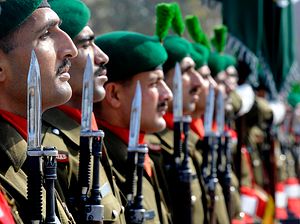A 14-year-old Islamic State (ISIS)-linked bomber attacked a Sufi shrine in Pakistan’s volatile Balochistan province on Saturday, killing at least 52 devotees and injuring over 100. This was the second attack claimed by ISIS in Balochistan in less than three weeks, after gunmen raided a police training center in Quetta, the provincial capital in October.
The Quetta Police College attack was simultaneously claimed by the Lashkar-e-Jhangvi’s (LeJ) Al-Alami (global) faction. While LeJ Al-Alami did not claim direct involvement in the Shah Noorani shrine attack, it highlighted that the group is working in tandem with ISIS in the immediate aftermath of the bombing.
Al-Alami spokesman Ali bin Sufyan told Reuters that “wherever there are attacks taking place [in Pakistan] Lashkar-e-Jhangvi Al Alami is cooperating with [ISIS] either directly or indirectly.”
LeJ, an anti-Shia militant group, evolved into a multi-faceted jihadist organisation after splintering into multiple groups. Despite the group’s primary target being the Shia community, it has been responsible for outrageous attacks elsewhere as well, including killing four US oil company workers in 1997, Daniel Pearl’s kidnapping and execution in 2002, the Marriott hotel bombing in 2008, the attack on the Sri Lankan cricket team in 2009, and the raid on Pakistan Army GHQ in the same year.
LeJ worked in tandem with the likes of Taliban and al-Qaeda for many of these attacks. Meanwhile, the Al-Alami faction announced its place in the South Asian jihadist network after collaborating with al-Qaeda to target a Shia pilgrimage in Kabul in 2011.
ISIS also targeted the Shias (Ismaili) when the jihadist group orchestrated its first attack in Pakistan, killing 43 members of the community. “Thanks to God 43 apostates were killed and close to 30 others were wounded in an attack by the soldiers of Islamic State (ISIS) on a bus carrying people of the Shia Ismaili sect … in Karachi,” the group’s statement read in the aftermath of the attack.
Pakistani Taliban splinter group Jundullah had been the ISIS foot soldiers in the Karachi bus massacre, just like Jamaat-ul-Ahrar had been in the Quetta hospital bombing in August. Taliban factions organically gravitated towards ISIS, with the Tehrik-e-Taliban Pakistan (TTP) regrouping following the initiation of military operation Zarb-e-Azb and ISIS looking to exaggerate the expansion of its “caliphate.”
On the ideological front Islamci State’s quest for “Islamic purification” through Shia-killing makes it a more natural ally for the Pakistani Taliban, with al-Qaeda not as passionate about killing “apostates” and the Afghan Taliban even condemning attacks on the Shia community.
While both TTP and LeJ offer anti-Shia outlets for ISIS, what makes the latter more lucrative for the Islamic State is its deeper penetration into the Punjab province, and even mainstream Pakistani politics.
LeJ originated in 1996 as an offshoot of the Sipah-e-Sahaba Pakistan (SSP), an anti-Shia militant organization. After being formally banned in 2002, SSP reincarnated as the Ahl-e-Sunnat Wal Jamaat (ASWJ), which has contested elections and formed coalitions with the Pakistan Muslim League-Nawaz (PML-N) in Punjab. In LeJ, ISIS has an operational alliance with a group that has had an understanding with the country’s ruling party and has enjoyed the support of the Pakistan Army.
Last year when former LeJ chief Malik Ishaq was killed in an encounter, it was believed that anti-Shia groups might now be dumped in the “Bad Taliban” category. But the government inviting ASWJ Chief Ahmed Ludhianvi to reach an understanding, amidst political pressure exerted by opposition parties a couple of weeks ago, confirms the contrary.
Now the question is whether the state will continue to acquiesce to jihadist violence outside Punjab to maintain a semblance of control over the province, as has been the case in the past.
With Gwadar Port formally launching trade through the China-Pakistan Economic Corridor (CPEC) on Sunday, the gateway of the much touted “lifeline” is in Balochistan. Can Pakistan, then, afford a volatile Balochistan?
One way to answer that question is through the center’s apparent focus on the eastern CPEC route, which passes through Punjab and Sindh and only enters Balochistan near the coastline, approaching Gwadar through a virtually horizontal highway. But it’s hard to imagine Beijing accepting terror activity around the outlet for its $46.2 billion investment, even if Islamabad might.
There are, hence, two potential offshoots of this weekend’s events in Balochistan. Either Pakistan reconsiders state patronage of jihadist groups, or the ISIS-LeJ alliance takes the fight to Punjab.
As ISIS core struggles to retain control over its hub in Mosul, it is the Islamic State umbrella that is strengthening militant Islamist groups in South Asia. Now that complete U.S. withdrawal from Afghanistan is imminent, and a Khorasan branch is already in place, ISIS might be eyeing another exploitable vacuum in the Af-Pak region.

































